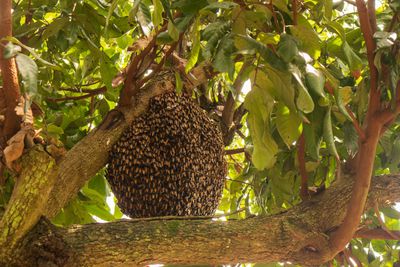Bee Swarm Removal & Control

Non Structural Swarms
For swarms—which are typically clusters of bees hanging from a tree branch, fence, or other outdoor surface—the process begins by identifying and capturing the queen whenever possible. Since the swarm is usually docile and temporarily resting while scout bees look for a new home, technicians can often gently collect the swarm by shaking or brushing the bees into a ventilated bee transport box or using a specialized bee vacuum with soft suction designed to prevent injury.
Non Structural Established Hives
For exposed hives, such as those attached to tree limbs, irrigation boxes, utility pedestals, or lawn ornaments, technicians will physically remove the entire hive, including the honeycomb, along with the bees. The area is then cleaned and treated with a pheromone-neutralizing enzyme to discourage reoccupation.
If the bees cannot be safely relocated due to aggression, location, or risk to public safety, a legal and controlled treatment may be used as a last resort. However, BeeCal prioritizes live removal and relocation whenever possible, often working with local beekeepers to ensure the bees are rehomed in a safe and sustainable environment.
Scout Bee Control
Scout bee stick traps are a preventative tool used to capture and monitor scout bees before a full swarm settles and establishes a hive. BeeCal Pest Management uses these traps strategically in areas prone to bee activity, such as attics, utility boxes, soffits, or voids that have had past infestations.
Here’s how they work:
- Attractant Placement: The stick traps are baited with a natural lure or attractant that mimics the scent of a suitable nesting site. This draws in scout bees—the first bees sent out by a colony to find a new home.
- Sticky Surface: When the scouts land on the trap, they become stuck to the adhesive surface, preventing them from returning to the swarm to report a suitable nesting site.
- Prevention Mechanism: By intercepting and eliminating scout bees, the trap disrupts the swarm's ability to find and settle in the area, significantly reducing the chance of a full hive forming.
- Placement & Monitoring: These traps are placed in discreet, high-risk entry points and monitored regularly. If scouts are caught, it signals heightened activity and allows BeeCal to take proactive steps, such as applying repellents or sealing access points.
Scout bee stick traps are especially useful in spring and early summer, when swarming activity peaks. They serve as both a monitoring tool and an early intervention method to prevent hive establishment in vulnerable structures.
Honey Bee Swarm Trapping
Bee swarm traps—also known as bait hives—are used by BeeCal Pest Management to lure and capture bee swarms before they settle in unwanted areas like attics, wall voids, or utility boxes. These traps are an effective, humane, and proactive method for managing bee activity, especially during peak swarming season.
How Bee Swarm Traps Work:
- Strategic Placement:
Swarm traps are placed in areas where swarming bees are likely to pass through or settle—typically high up and near previous hive sites, tree lines, roof eaves, or utility structures. Placement is critical for success. - Lure with Attractants:
Each trap is baited with bee-attracting pheromones or essential oils (such as lemongrass oil) that mimic the scent of an ideal nesting site. These scents attract scout bees that are searching for a new home. - Hive-Simulating Design:
The trap is designed to mimic a hollow cavity bees would naturally choose, usually with a small entrance and enough interior space to house a new colony. It creates the illusion of a safe, ready-to-move-in hive. - Capture the Swarm:
Once scouts approve the location, the full swarm—often thousands of bees—will move into the trap. At this point, BeeCal technicians return to securely remove the trap, safely containing the bees for relocation. - Relocation or Transfer:
The captured bees are then relocated to a managed hive or turned over to a local beekeeper, keeping the bees alive and out of human structures.
Benefits of Swarm Traps:
- Prevent bees from colonizing unwanted areas
- Support humane live relocation
- Help reduce property damage and liability
- Effective early intervention method
Swarm traps are especially valuable in areas with a history of bee issues, and BeeCal often uses them in combination with scout stick traps, sealing, and pheromone treatments for a comprehensive bee prevention strategy.
This website uses cookies.
We use cookies to analyze website traffic and optimize your website experience. By accepting our use of cookies, your data will be aggregated with all other user data.